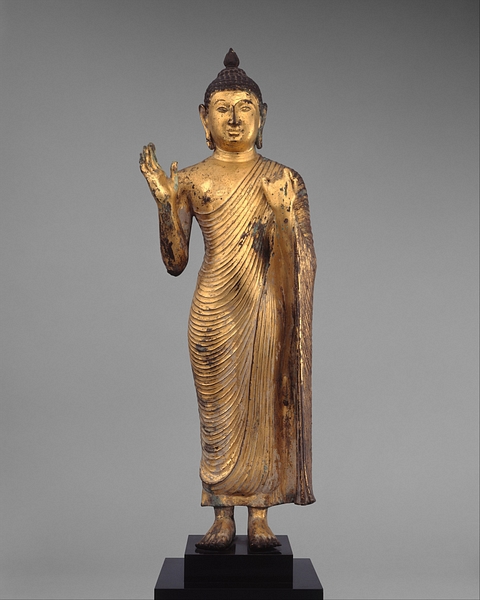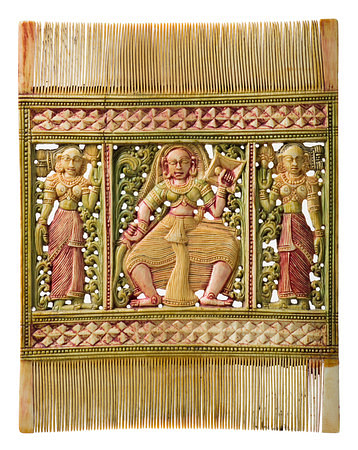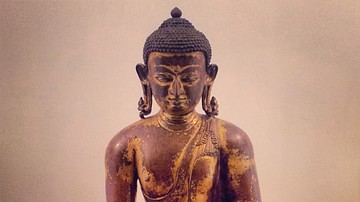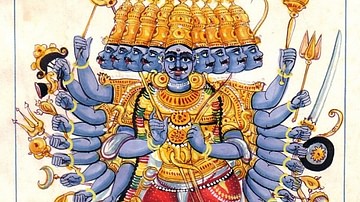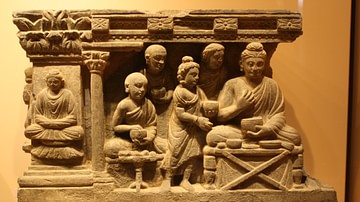The first comprehensive survey of Sri Lankan art organized by an American museum, The Jeweled Isle: Art from Sri Lanka, on show now at the LACMA in Los Angeles, California, presents some 250 works addressing nearly two millennia of Sri Lankan history and art. Featuring LACMA's rarely displayed collection of Sri Lankan art—one of the finest and most extensive in the U.S.—the exhibition presents a timely exploration and celebration of a geographically complex, ethnically diverse South Asian nation. In this exclusive interview, James Blake Wiener, Ancient History Encyclopedia's Communications Director, speaks to curators Dr. Robert L. Brown and Dr. Tushara Bindu Gude about this groundbreaking exhibition and Sri Lanka's important role in South Asian art history.

JBW: Sri Lankan art is not nearly as well known in the West as the arts of neighboring India, Nepal, and Tibet. Why do you believe this is the case given Sri Lanka's rich cultural heritage and strategic location in the Indian Ocean? Moreover, why has the LACMA decided to organize an exhibition solely on the arts of Sri Lanka?
RB and TBG: One of the reasons LACMA decided to pursue an exhibition on Sri Lankan art in the first place was precisely because of this huge gap in knowledge. You are correct that Sri Lankan art is not as well known as the art of India and the Himalayas. That has partly to do with the fact that the Theravada Buddhism associated with Sri Lanka was perceived as far more traditional than the Mahayana Buddhism that had emerged in India by the early centuries CE. Its art also presented a different path of development.
It was the Mahayana tradition which became dominant in India and forms the basis for the Buddhism we find in Nepal, Tibet, China, Korea, Vietnam, and Japan. Sri Lanka's Theravada traditions were tremendously important, however, to Southeast Asia. Burma, Cambodia, Thailand and Laos are all Theravada Buddhist countries with various historical links to Sri Lanka. Yet, their visual traditions, over time, followed a different trajectory, having more in common with one another than with Sri Lanka. So, Sri Lanka has always occupied a place along the peripheries of both South and Southeast Asia in the art historical literature and in museums. The goal of this exhibition is to finally bring the island, strategically located along maritime routes extending to its east and west, to the front and center.
Another reason LACMA pursued this exhibition is because we have an excellent collection of Sri Lankan art, about 90% of which has never been exhibited. Once we started to examine it more closely, we came to realize that its quality, diversity, and range would allow us to put together an exhibition that was more comprehensive than previous U.S. shows on Sri Lanka. Those have tended to focus primarily on the island's Buddhist sculptural traditions. LACMA's exhibition includes a number of artworks that speak to the interaction of a diverse range of religious and cultural traditions. The nearly 30 year-long civil war in Sri Lanka was largely fought along ethnic and sectarian lines, but the art shows how the island's people and religions were very closely linked historically.
JBW: Rare images of Hindu gods showcased within The Jeweled Isle attest to a long and constant interaction between Sri Lanka and South India. How does the exhibition trace and frame Sri Lanka's multifaceted connections to the Indian Subcontinent?
RB and TBG: Sri Lanka's connections to India are a very important theme throughout the exhibition, and are attested by artworks spread throughout every section of the show. We have to remember that only 32 km (20 mi) separate India and Sri Lanka at their closest geographical points. There was a constant flow of ideas and people both to and from both places. Buddhism and Hinduism were born in India. Vijaya, the legendary founder of the Sinhalese people and progenitor of the island's first kings, was an Indian prince. At the same time, the island looms especially large in the Indian imagination because of its association with the island-fortress of the demon-king Ravana, as immortalized in the Ramayana epic. In this Hindu epic, the victorious god Rama crowns Vibhishana, the brother of Ravana, as the king of Lanka. Vibhishana is still revered by Sri Lankans as one of the island's great guardian gods.
We wanted to acknowledge this aspect of Sri Lanka's cultural history but also show that Indian culture was not transplanted wholly onto the island. From the early centuries CE, Sri Lankan art developed a unique and recognizable character, as the Indian traditions—Buddhist and Hindu—interacted with indigenous ones. We tried to establish the approach very early on in the exhibition. The first gallery, for instance, includes a set of 16 painted wooden panels—likely door or window shutters—dating from the 18th century CE and depicting Brahmanical gods in addition to navagraha, or nine astrological deities.
![The Jeweled Isle: Art from Sri Lanka Exhibition, LACMA [3]](https://www.worldhistory.org/img/r/p/500x600/9767.jpg?v=1599127203)
The Brahmanical gods include Vedic deities like Indra but also Hindu gods such as Shiva, Vishnu and Ganesha. The remarkable thing is that these panels probably come from a Buddhist shrine, judging from similar panels still found in situ. It is a very complex process, but Buddhism essentially integrated the power and protection of these gods into its own cosmologies, histories, and rituals. In a Buddhist context, the Brahmanical gods do not have the same cosmic importance as they do for Hindus. Rather, they are intercessors in the world of men, and are subordinate to the Buddha who has transcended even the heavens. Additionally, several of them are considered protectors of the Buddhist teaching.
The exhibition also includes objects of a more obvious Hindu nature, such as a rare twelfth-century CE bronze image of Shiva Nataraja (Shiva as Lord of the Dance) from Polonnaruwa. Images like this, in a style associated with the South Indian Chola dynasty (300s BCE–1279 CE), started to be produced after the Cholas invaded Sri Lanka in the late 10th century CE. The Cholas ruled for less than a century, but later Buddhist kings continued the patronage of Hindu temples. Other objects in the exhibition view the Indian and Sri Lankan relationship from different angles—revealing a shared repertoire of architectural devices, for instance, or exploring the textile trade between the two regions. One striking thing to bear in mind is that many Sri Lankan kings and noble families maintained close relationships with their counterparts in south India. The last four kings of Sri Lanka, in fact, were descended from a Hindu dynasty in India and can be counted among the most active patrons of Buddhist art in the island's history.
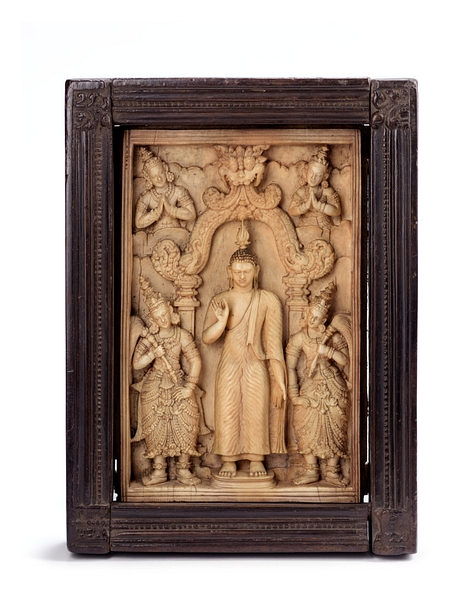
JBW: Sri Lanka's history and culture are inextricably tied to the rise and development of Buddhism in Southeast Asia. Nearly 70% of Sri Lankans continue to follow Theravada Buddhism today which first emerged as a distinct school of early Buddhism in ancient Sri Lanka. How did you convey the importance of sacred Buddhist sites and relics from Sri Lanka within the exhibition?
RB and TBG: Yes, Sri Lanka is predominantly a Theravada country and this, of course, is reflected in much of Buddhist art that was produced there. We took a deliberate position in this exhibition and did not attempt to trace stylistic or iconographic developments. Nor did we try explicitly to link doctrinal developments with visual ones. However, the very nature of the Sri Lankan Buddha image, and the lack of such figures as cosmic Buddhas and bodhisattvas, makes the point of Theravada's visual and doctrinal distinctiveness quite clear throughout the exhibition.
The Theravada Buddhism of Sri Lanka focuses especially on the Buddha of our historical period, Shakyamuni, and stresses his life and previous births. The dominant image in all Sri Lankan Buddhist temples is the Buddha, usually shown seated in meditation, standing in a gesture of exposition or assurance, or reclining at the moment of death. Although both Theravada and Mahayana schools were present and active at the ancient Sri Lankan city of Anuradhapura, the Theravada had eclipsed its rivals by the 12th century CE. Theravada Buddhism does not admit any bodhisattvas except for Shakyamuni, who was a bodhisattva before his enlightenment, and Maitreya, the future Buddha.
![The Jeweled Isle: Art from Sri Lanka Exhibition, LACMA [1]](https://www.worldhistory.org/img/r/p/500x600/9765.jpg?v=1599127202)
Only two bodhisattva images are in the show, both of them quite rare: a 9th-century CE sculpture identifiable as Avalokiteshvara, and an 11th-century CE figure that clearly represents a bodhisattva but is of a more generic type. In a general sense, the dominance of the Theravada school is what accounts for the limited sculptural repertoire we find in Sri Lankan Buddhism. Nevertheless, the several Buddha images throughout the exhibition demonstrate the great skill and inventiveness of Sri Lankan artists.
Another type of Buddhist sculptural object that features in the exhibition is the reliquary container fashioned in the shape of a stupa or burial mound. Buddhist relics are one of the lenses through which the exhibition examines Sri Lanka's sacred sites and the relationship of kingship to the custodianship of Buddhism. Three major historical capitals of Sri Lanka are each addressed in separate sections of the exhibition—Anuradhapura, Polonnaruwa, and Kandy. The establishment of Buddhism in Sri Lanka is associated with the legendary travels of the Buddha to the island, and with the later arrival of his relics, several of which were housed at monastic centers in Anuradhapura.
Two pairs of manuscript covers in the exhibition depict the solosmasthana, sixteen pilgrimage sites that are associated either with the Buddha's visits or with the establishment of relics. One of the Buddha's relics, a tooth, was brought to Anuradhapura from India in the 4th century CE and became a "palladium of rule." It was taken into hiding during times of crisis, such as the Chola sack of Anuradhapura in the late 10th century CE and during the centuries of fragmented rule following the collapse of the Sri Lankan city of Polonnaruwa. The tooth relic is now housed in Kandy, where it was installed during the 16th century CE. Its annual procession was the occasion for great artistic expression, which the Kandy section of the exhibition examines in detail.
JBW: The image of a bejeweled isle, invoked in ancient Sanskrit texts and in Greco-Roman accounts of Sri Lanka's precious gems, inspired numerous literary descriptions of the island's wealth and lush tropical beauty. How is the notion of “jewels” apparent throughout the exhibition, figuratively and literally?
RB and TBG: Literary texts and historical accounts—Indian, Greek and Roman, Arab, Persian, Chinese, and European—attest to Sri Lanka's fame as a gem-producing island. In Indian and Sinhalese sources, Sri Lanka is often called "Ratnadvipa," or "island of jewels." In a way, we consider all the artworks in the exhibition to be jewels of a sort, but we do include some striking mineralogical gems—including variously hued sapphires, for which Sri Lanka is still famous—in the first gallery of the exhibition. We did this to suggest Sri Lanka's legendary allure, but also to foreground the notion of jewels, so prominent in the exhibition title, as an organizing principle for the exhibition.
The gems in the first gallery play off a number of nearby 19-century CE photographs that allude to the manner in which jewels were a common metaphor for describing the island—its emerald canopies and its sapphire waters and skies, for instance. Also in the first gallery, a striking 19th-century CE seated Buddha image from LACMA's collection refers to another understanding of jewels. The Buddha (including his images), the monastic community, and the Buddha's teachings comprise what is known in Buddhism as the triple gem, or triratna. All the Buddhist art in the exhibition reflects, in various ways, aspects of the triple gem. Finally, the Buddha's relics are often described as jewels, and as we mentioned before, relics are conceptually important to this exhibition's presentation of Buddhist history and practice in Sri Lanka.
![The Jeweled Isle: Art from Sri Lanka Exhibition, LACMA [4]](https://www.worldhistory.org/img/r/p/500x600/9768.jpg?v=1599127203)
JBW: I was curious to read that The Jeweled Isle includes a large number of photographs from the 19th century CE when Sri Lanka was a British Crown colony. What do the photographs reveal, and how do they connect to the other topics presented within the exhibition?
RB and TBG: There are about 70 late 19th-century CE photographs in the exhibition, all taken by Victorian British photographers—including Joseph Lawton, William Skeen, and Charles Scowen—who lived and worked in what was then called "Ceylon." They are a crucial part of the show and are extraordinarily beautiful artworks in their own right. The photographs are in every gallery of the exhibition and amplify its themes in various ways. We have already mentioned that the photographs in the first gallery, for instance, present exceptional views of the island's natural beauty, suggesting its jewel-like appearance. In other sections the photographs provide context.
For example, among the objects in the second gallery, which addresses the early capital of Anuradhapura and the establishment of Buddhism in Sri Lanka, are reliquaries, decorative objects adorned with Bodhi leaves, and a large painting of the Buddha's footprint on Adam's Peak. The sites associated with the Buddha's visits and with important relics—which include the branch from the Bodhi tree brought to Sri Lanka in the 3rd century BCE—are living monuments that could only be addressed through the photographic record. In other parts of the exhibition, photographs of Sri Lankan nobility are juxtaposed with textiles, ceremonial weapons, ivory combs, and jewelry, helping to round out the picture of courtly wealth and display. Other photographs demonstrate the relationship between architecture and the decorative arts.
A spectacular group of 13 botanical photographs by Charles Scowen, taken in the Peradeniya gardens at Kandy, are something of a highlight in the exhibition. The Peradeniya gardens were the former royal gardens of the Kandyan kings. After the British deposed the last king of Kandy in 1815 CE, these gardens were appropriated by the colonial government and, in 1822 CE, inaugurated as the Royal Botanical Gardens. As such, they came to operate as another node in the British imperial network of gardens that facilitated the vast global exchange of plants and scientific knowledge in the late 19th century CE.
These images especially remind us how objects of great beauty were yoked to the implementation of colonial rule. In a way, all of the 19th-century CE photographs operate on this level. We intended that they would serve as something of a meta-narrative throughout the exhibition, as Sri Lanka was deeply impacted by colonial forms of knowledge and representation.
Sri Lankan photographers from this period are unknown, though they must certainly have been among the staff of the major commercial studios. As a counterpoint to the British colonial images, then, we decided to include, in the last gallery of the exhibition, 20 works by the Sri Lankan photographer Reg van Cuylenburg (1926-1988 CE). Van Cuylenburg was the son of a Kandyan Sinhalese mother and an English father, and was trained by Lionel Wendt, Sri Lanka's most famous modernist who was also of mixed Sinhalese and European parentage. Between 1949 and 1958 CE, Van Cuylenburg undertook several tours across Sri Lanka, documenting the various places he visited, the festivals he witnessed, and the people he encountered.
![The Jeweled Isle: Art from Sri Lanka Exhibition, LACMA [2]](https://www.worldhistory.org/img/r/p/500x600/9766.jpg?v=1599127203)
His photographs represent a Sri Lankan's own view of a much-beloved homeland, taken in the optimistic years just following Sri Lanka's independence. Of particular interest is the fact that several of his photographs depict the devotions at Kataragama, which is now the most famous pilgrimage site in Sri Lanka and one visited by Buddhists, Hindus, Christians, and Muslims. Because the site rose to prominence in the 20th century CE, few images of it exist in the colonial archives.
JBW: How does one differentiate between the various influences that were woven together into the fusion that is Sri Lankan art? Was this a challenge for the LACMA as it began to plan the exhibition and assemble the objects that would go on display?
RB and TBG: It was definitely a challenge because the influences were so many and the scope of the show—nearly two millennia—so broad. The influences were not just stylistic either, but had to do with religious and devotional developments as well as with historical processes. In some ways, we were informed by Sri Lanka's own written history. For instance, we are told in the Mahavamsa, the great 5th century CE Sri Lankan chronicle, that the island was the abode of fierce nature and serpent deities prior to the establishment of Buddhism.
The chronicle details the coming of the Buddha and the establishment of the faith as well. We saw that these aspects of history and belief—which also highlight indigenous beliefs and the island's close relationship with India—were given expression in art and architecture over a period of 2,000 years. So we knew that this was a relationship that had to be demonstrated, explored, and explained further. And these explorations led us into all kinds of interesting areas, such as the roles of local gods in Buddhist worship and ritual. Seeing what was uniquely Sri Lankan, in the end, wasn't that difficult, as there was always a rapid assimilation of forms into local vernaculars.
JBW: What do you believe will surprise museum visitors as they walk through The Jeweled Isle? Additionally, what are your personal hopes for this exhibition and favorite items found within the show?
RB and TBG: We think people will be surprised by the great cultural complexity that the artworks in the exhibition demonstrate. Those who know little of Sri Lanka's history will also be surprised at the great sophistication of thought behind many of the artworks. Our hopes are that people will be delighted by the visual power and presence of the art and that these, in turn, will lead them to engage with the ideas and history behind them. There are so many interesting and beautiful objects in this exhibition; we really don't know how we could pick our favorites from among them. We selected every one of them, after all!
JBW: Dr. Robert L. Brown and Dr. Tushara Bindu Gude, I thank you so much for your time and consideration. I wish you much success, and I hope our paths cross again.
RB and TBG: Thank you so much for your interest!
The Jeweled Isle: Art from Sri Lanka runs at the LACMA in Los Angeles, California until June 23, 2019.
Dr. Robert Brown is the Associate Curator in South and Southeast Asian Art at the LACMA museum in Los Angeles. He graduated from the University of California, Los Angeles with a PhD in Indian art history in 1981. Immediately after graduation he worked at LACMA and was promoted to Curator of Indian and Southeast Asian Art in 1984. In 1986 he began teaching at UCLA where he is presently professor of art history. In 2000 he was reappointed as curator in the Department of South and Southeast Asian Art at LACMA, a position he holds with his UCLA professorship. His publications include over 100 books and articles on Buddhist and Hindu art, on the nature of Indian artistic influence in Southeast Asia, and on the colonial and Western basis for art historical understanding of India. He is presently writing a book on the Gupta-period Buddha images from Sarnath (India). Four recent publications include edited books: Art from Thailand (Marg 1999), Roots of Tantra (SUNY 2002), the Encyclopedia of India, 4 vols. (Charles Scribner's Sons 2005), and Studies on the Art of Ancient Cambodia: Ten Articles by Jean Boisselier, trans. and ed. with Natasha Eilenberg (Reyum, 2008). His online catalogue of the Southeast Asian Collection at LACMA was launched in 2013.
Dr. Tushara Bindu Gude is the associate curator in the South and Southeast Asian Art Department at LACMA, a position she has held since 2006. Prior to joining LACMA she served for six years as assistant curator of South Asian art at the Asian Art Museum in San Francisco. Gude received her PhD in Art History from the University of California, Los Angeles. Her particular areas of research, expertise, and interest include Indian Buddhist art, South Asian courtly paintings, art of the colonial period, and the modern and contemporary art of South Asia. Her past exhibitions at LACMA include Pinaree Sanpitak: Hanging by a Thread (2013) and India's Fabled City: The Art of Courtly Lucknow (2010–11). Gude has also curated several permanent collection exhibitions including A Connoisseur's Delights: Indian Paintings from the Nasli and Alice Heeramaneck Collection (2007–08), Princely Traditions and Colonial Pursuits in South Asia (2013–14), Landscapes of Devotion: Visualizing Sacred Sites in India (2014–15), Devi: The Image of the Goddess in Nepal (2015–16), Buddhism, Trade, and Diplomacy: Relationships Between Tibetan and Chinese Art (2016–17), and Monsoon: Indian Paintings of the Rainy Season (2016–17). In addition to various scholarly publications, she has contributed essays to several exhibition catalogues including India's Fabled City: The Art of Courtly Lucknow, Kingdom of the Sun: Indian Court and Village Art from the Princely State of Mewar, Holy Madness: Portraits of Tantric Siddhas, and The Kingdom of Siam: The Art of Central Thailand, 1350–1800. She was co-curator of the exhibition Las Huellas de Buda (Traces of the Buddha) (Museo Nacional de Antropología, Mexico City, July 19–October 14, 2018), which was the first pan-Asian Buddhist exhibition to be held in Mexico City, Mexico.

